The iPhone 7 and iPhone 7 Plus Review: Iterating on a Flagship
by Joshua Ho & Brandon Chester on October 10, 2016 8:00 AM EST- Posted in
- Smartphones
- Apple
- Mobile
- iOS
- iOS 10
- iPhone 7
- iPhone 7 Plus
GPU Performance
Section by Brandon Chester
Now that the general system and CPU performance of A10 Fusion has been characterized, we can move on to more focused benchmarks for the GPU and the storage subsystem. Apple's keynote for the iPhone 7 actually disclosed that the GPU in A10 Fusion is a six core part. The last time I recall Apple mentioning specifics about their GPU was with the launch of the iPad 3, where the GPU was advertised as a quad core implementation that turned out to be SGX543MP4.
The use of a six core GPU is interesting because there's not much choice for Apple given that A9 also used the six core PowerVR GT7600. It really boils down to three possibilities. The first is that Apple has actually continued using the exact same GT7600 microarchitecture as on the A9, albeit with an improved layout on the die. The second is that Apple has moved to PowerVR GT7600 Plus, which brings some improvements to integer compute performance, and memory bandwidth optimizations. And the third is the wildcard option - that Apple has put to use its significant GPU engineering resources on a more customized design; something that's still using the PowerVR architecture, but more custom than ever before. This is a longer discussion to have in our full deep dive, but Ryan's of the opinion that this is somewhere between options two and three, that Apple has done some significant work to produce a highly optimized version of the PowerVR GT7600 Plus
In any case, as Apple isn't using a radically different GPU architecture, most of Apple's stated 50% increase in GPU power comes from increasing the clock speeds, with optimizations such as memory and caching picking up the rest. This is interesting because Apple also advertises that A10 Fusion's GPU uses only two thirds the power of A9, which would indicate a lot of work done by Apple to optimize for power usage.


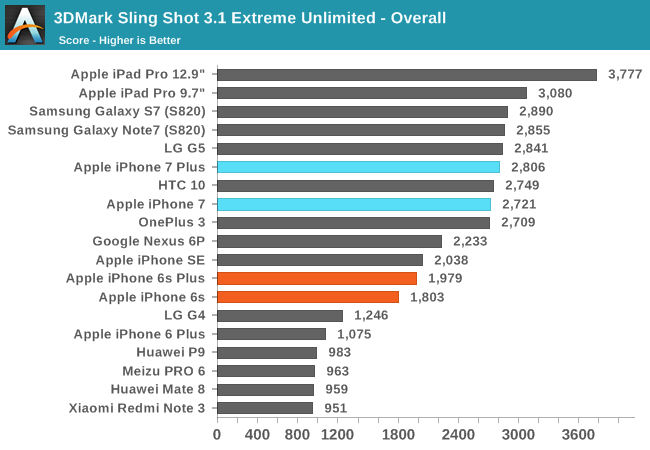
3DMark Sling Shot is broken down into a few different tests, and at the end the results of graphics tests and physics tests produce separate scores which are then used to generate an overall score.
In the graphics test the results are in line with Apple's stated GPU performance improvement of 50%. The physics score, which is really a CPU test, only improves by 30-35%, which has a direct correlation to the increase in peak clock speed from 1.8GHz on A9 to 2.3GHz in A10 fusion.
Like Ice Storm, the physics test is still basically a chart of devices ranked by cores multiplied by max frequency, and you can see that the iPhones have improved very little over the years, with the improvements tracking closely to Apple's increases in CPU clock speed. This comes down to the test being designed in such a way that there's little instruction level parallelism to exploit due to memory dependencies, which puts Apple's wide dual core CPU at a disadvantage. While it is certainly a valid test situation, it's not really reflective of actual 3D game performance because you would generally not write a game in such a way that it cannot exploit the performance of its target hardware.
Even with the smaller improvement in the physics tests, the overall score for the iPhone 7 is still roughly 50% higher than the Apple A9 devices like the iPhone 6s and SE.
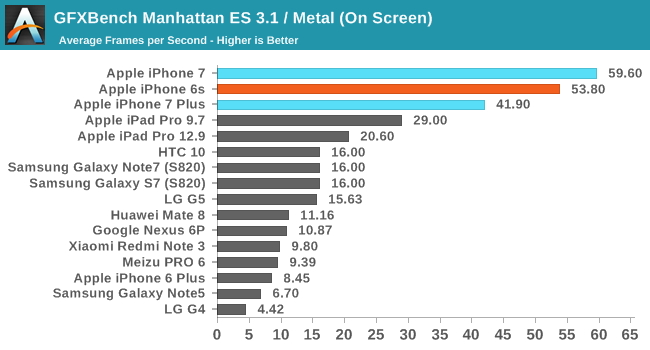
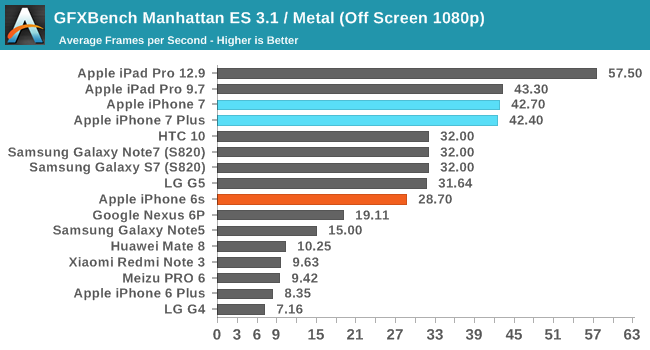
We originally migrated away from Manhattan ES 3.0 to Manhattan ES 3.1 / Metal to push back on devices hitting VSync in the on screen tests. Unfortunately it didn't work for long. With the iPhone 7's increase in GPU performance not being accompanied by an increase in display resolution, the on screen result in GFXBench Manhattan is higher than any other device, and is essentially at the display's refresh limit. The iPhone 7 Plus isn't able to hit Vsync due to its higher resolution, but the on screen result of roughly 42fps is nothing to scoff at either considering the visual complexity of the test.
While on screen performance is helpful from the perspective of someone who wants to see how the phone will actually perform when running a game at its native resolution, to compare directly between devices you need to standardize the rendering resolution. As its name implies, GFXBench's off screen test simply renders all the frames at 1080p in an off screen buffer. In this test the iPhone 7 and 7 Plus both run slightly below 43fps, which puts them right where you'd expect from Apple's claim of 50% greater GPU performance. In GFXBench this also puts the two of them at the same level as the 9.7" iPad Pro for absolute GPU performance.
This gives some interesting insight into the relative clock speeds that Apple is running their GPUs at, as A9X uses a twelve core PowerVR Series7XT GPU, while A10 Fusion uses only six. As I mentioned before, the performance improvements in A10 Fusion primarily come from increasing the peak clock speed. Matching the 9.7" iPad Pro's A9X suggests that Apple has targeted a fairly aggressive clock speed for the GPU in A10 Fusion, and while we can't verify Apple's claim of A10's GPU running at only two thirds the power of A9, if that is indeed the case it would represent a great deal of optimization effort on Apple's part to achieve that despite increasing clock speeds this significantly.
Storage Performance
One of the big changes that came with Apple's A9 and A9X SoCs was a new storage controller designed internally at Apple. This was not the first Apple product to use an in-house SSD controller, as the 2015 MacBook used a PCIe SSD and adopted the NVMe interface. A9 and A9X adapted this for use in mobile, and the sequentual performance in particular was far ahead of anything in a competing mobile device.
Apple hasn't advertised any improvements to storage performance with A10 Fusion, but it's worth running tests to verify that performance has remained at the same level. There are also potential gains in write performance when increasing the total capacity of an SSD by adding additional dies. At this point there's really no benchmark that can give comperable results between iOS and Android, so I've decided against doing a cross-platform comparison here.
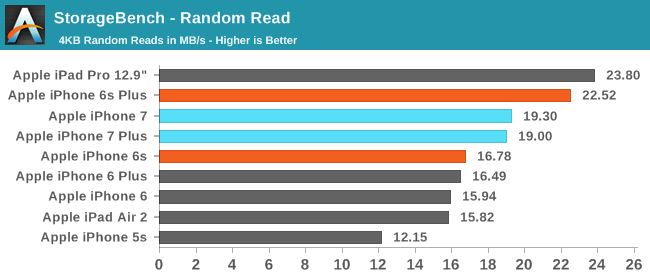
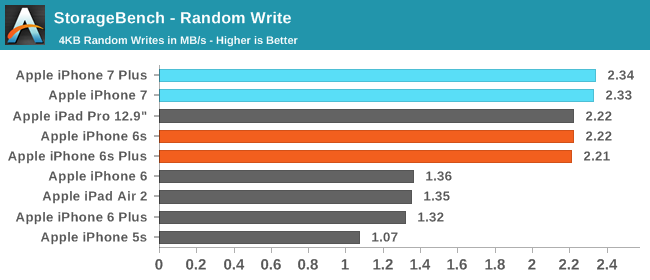

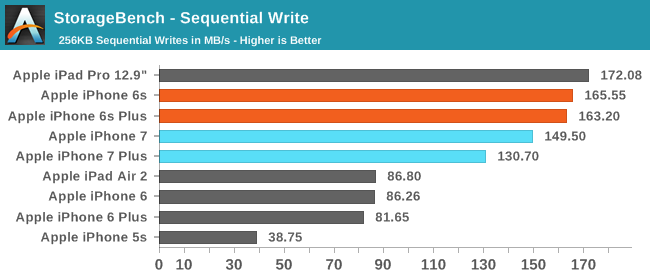
In general, the NAND performance of the iPhone 7 and 7 Plus is equivalent to the iPhone 6s and 6s Plus. There are some minor differences, but essentially all of them can be attributed to testing variance. The only thing that is worth noting is that there's no significant improvement to write performance even though the iPhone 7 units tested are 256GB models while the 6s and 6s Plus were 128GB models. This suggests that the NAND packages use higher capacity dies so there's no additional parallelism to take advantage of.










377 Comments
View All Comments
solipsism - Monday, October 10, 2016 - link
So you want legislation to artificially control smartphone prices and kill the free market. Brilliant¡If you graph the supply and demand for the iPhone you'll see that equilibrium price is actually lower than it could be. Meaning, Apple is actually losing money in the short term, but this isn't altruistic, but designed to help capture the market for the longterm, therefore increasing their overall profitshare. Economies of scale are already maxed out at it is.
The cost of components or what you perceive as the value of a smartphone is irrelevant—all that matters is what the market dictates. If you feel that high-end smartphones are too expensive, then don't buy them. They did release an iPhone SE because the market wanted a 4" model. If you and enough others stop buying smartphones in this price range you'll see that ARP drop. This happened in India.
jlabelle2 - Friday, October 14, 2016 - link
"They did release an iPhone SE because the market wanted a 4" model"Not at all. If it was the case, the sales of the iPhone 6 would not have been so huge compared to previous model.
The release the SE because they wanted to target people not willing to spend 750-850$ on a phone. The SE is selling mostly because it is half the price and the cheaper iPhone ever sold.
grayson_carr - Monday, October 10, 2016 - link
The price of iPhones has not risen. What are you talking about?grayson_carr - Monday, October 10, 2016 - link
The first iPhone was originally $599 subsidized with a two year contract, meaning over $1000 were it not for the subsidy, and the base model iPhone 3G was priced much lower at $599 full price without a contract, but that still equates to ~$670 today when you factor in inflation. So at a starting price of $649, the iPhone 7 is cheaper today than iPhones were 8 years ago accounting for inflation.StrangerGuy - Monday, October 10, 2016 - link
I didn't knew owning luxury goods is a fundamental human right.It doesn't matter much you stinkers try to hide your entitlement syndrome under the guise "for the greater good", you still get smelled a million miles away.
kogtsalami - Monday, October 10, 2016 - link
Small correction: The iPhone 4 was not made of aluminium but stainless steel.JoshHo - Tuesday, October 11, 2016 - link
The intent was to say that the iPhone 4 was one of the first smartphones to use external antennas integrated into the design rather than internal antennas embedded in RF windows.dsraa - Monday, October 10, 2016 - link
No mention of the audio performance through the new dongle? what about bluetooth sound?? I know this is a brief review, but at the very least their should be a section on audio and how it compares to the 6s since there it is now done through a digital 'adapter'???TechnologyGuy - Monday, October 10, 2016 - link
Sorry as usual with an iPhone review here - great on the details but illogical conclusions. The removal of 3.5mm headphone jack doesn't matter? That's a clear deal breaker for me, especially when AirPods for me literally belong in the garbage and having invested $1000's on headphones in the past. Not sure what you mean about the camera - iPhones have now barely caught up in quality, but clearly still lagging behind the S7 and Pixel. The iPhone 7 battery life is mediocore at best, and without fast charge or wireless charging - another automatic deal breaker for me. The screen is just passable in comparison to the competition.So really, the only thing that is industry-leading is the SoC, and I think at least for me, that hardly compensates for all the subpar areas. I am not sure why you are so obsessed with the SoC and system performance when the overall experience based on the components (at least those that matter in day-to-day usage - screen, camera, battery life/charging) is no batter than your average $300 phone. My experience with a phone does not depend how good I feel about the SoC under the hood. This phone is a clear no for me and not worth the $650-750 USD.
mrochester - Monday, October 10, 2016 - link
You're forgetting that you need to consider the OS and ecosystem too. A phone isn't just a bunch of hardware components, and it's an OS and software layer too, which is much more important than the hardware anyway.